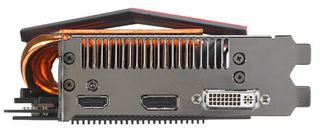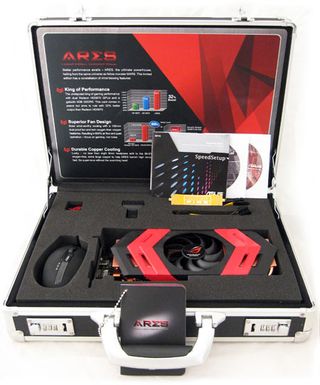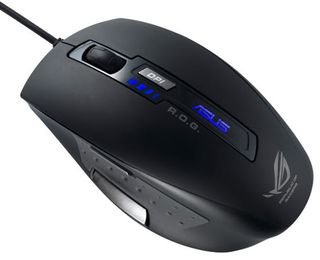Asus ARES: Is This The One Graphics Card To Rule Them All?
Asus' new ARES immediately earns bragging rights as one of the fastest single graphics cards ever created. We put the beast through a gauntlet of tests to measure this product's true power. At the end of the day, we answer whether it's worth four digits.
It's Not A Radeon HD 5970. It's A Radeon HD 5870 X2

Put simply, the Asus ARES (officially designated as the ARES/2DIS/4GD5) is a 4 GB Radeon HD 5870 X2 consisting of two 2 GB Radeon HD 5870s in CrossFire on a single card.
You might be tempted to call the ARES a Radeon HD 5970. But remember that the 5970 runs core and memory clock rates 125 MHz and 200 MHz slower than the Radeon HD 5870 spec, respectively:
| Header Cell - Column 0 | Radeon HD 5970 | Asus ARES | Radeon HD 5870 CrossFire |
|---|---|---|---|
| Shader Processors: | 3200 (1600 x 2) | 3200 (1600 x 2) | 3200 (1600 x 2) |
| Texture Units: | 160 (2 x 80) | 160 (2 x 80) | 160 (2 x 80) |
| Color ROPs: | 64 (2 x 32) | 64 (2 x 32) | 64 (2 x 32) |
| Core Clock: | 725 MHz | 850 MHz | 850 MHz |
| GDDR5 Memory Clock: | 1000 MHz | 1200 MHz | 1200 MHz |
| Memory Bus: | 256-bit | 256-bit | 256-bit |
| Memory Bandwidth (GB/s): | 128 | 153.6 | 153.6 |
| Compute Power (TFLOPs): | 4.64 | 5.44 | 5.44 |
| Total Transistors (billion): | 4.3 | 4.3 | 4.3 |
| Maximum Power: | 294 W | ~350 W* | 376 W (188 W x 2) |
| Idle Power: | 42 W | ~45 W* | 53 W (27 W x 2) |
| *estimated based on observed power usage |
The ARES runs both of its GPUs at the same 850 MHz core and 1200 MHz memory as the reference Radeon HD 5870, and therefore deserves to be called a Radeon HD 5870 X2. Don't overlook the fact that the ARES sports double the GDDR5 RAM of the reference Radeon HD 5970 (4 GB instead of 2 GB), another performance-enhancing feature.


The heart of this card is its unique heat sink and fan. Asus claims the fan will flow 119 CFM compared to the reference Radeon HD 5970's 18 CFM fan, and that it'll do the job with less noise: 37 dB versus the reference card's 44.5 dB. The company also claims that the card's eight 8 mm heat pipes and two blocks are made of 99.9% oxygen-free copper that will conduct heat 1.7 times better than aluminum.
We'll see just how loud and cool the card is in our noise and heat benchmarks a little later, but based on looks alone, the cooling system is impressive. Speaking of looks, the cooler design is based on the Asus EN7800GT of yore, the company's first dual-GPU model released some five years ago.

The outputs on the card are somewhat unique. Instead of the dual-DVI and mini-DisplayPort setup we're used to seeing on the Radeon HD 5970, the ARES has one dual-link DVI, one HDMI, and one DisplayPort output. With 4 GB of RAM onboard, it's a pity this card doesn't come with six outputs like the Radeon HD 5870 Eyefinity Edition. Then again, the cooling challenges such a crowded back panel would present are understandably prohibitive, too.

While the standard Radeon HD 5970 requires one 8-pin and one 6-pin PCIe power cable, the ARES ups the ante with another 8-pin connector. Almost staggeringly, you'll need one 6-pin and two 8-pin PCIe power cables to run this monster. Luckily, the bundle comes with two 6-pin-to-8-pin adapters, but if your PSU doesn't include any 8-pin headers, you're going to need five 6-pin PCIe cables to make it work. Then again, if you're shopping for graphics cards that cost more than most decent gaming PCs, we shouldn't need to tell you to go out and buy a comparably decked-out power supply.
Stay On the Cutting Edge: Get the Tom's Hardware Newsletter
Join the experts who read Tom's Hardware for the inside track on enthusiast PC tech news — and have for over 25 years. We'll send breaking news and in-depth reviews of CPUs, GPUs, AI, maker hardware and more straight to your inbox.

Asus' bundle includes two 6-pin-to-8-pin adapters, the appropriate manuals, driver and utility CDs, a CrossFire connector, an HDMI-to-DVI adapter, an RoG case badge, and the coup de grace: an Asus GX800 gaming mouse.

The lack of a bundled game is conspicuous, but the inclusion of a programmable 3200 dpi gaming mouse lessens the disappointment. The mouse is a value-add, so I'm not going to devote a lot of time to reviewing it. But it's a comfortable, attractive product with a lot of programmable buttons and on-the-fly variable resolution. This is a fine gaming mouse. My personal opinion is that I'd prefer it to be a little heavier, and I think five separate resolutions are a little much for quick changes. No matter how you slice it, though, this is a premium gaming mouse worth $60 or so. Here is a screenshot of the GX800 configuration utility:

Current page: It's Not A Radeon HD 5970. It's A Radeon HD 5870 X2
Prev Page ARES, The Greek God Of War Next Page Installation And Overclocking the ARES-
rohitbaran On the second page, that should be Radeon 5970, not Radeon 5890. There isn't any card on the market as 5890.Reply -
rohitbaran BTW, it would be really cool to see a 5890, for that would give the GTX 480 a run for its money, something it is already not earning! :DReply -
Maziar Great review,Reply
However i agree with Tom's about that there are better options in terms of price/performance ratio.This card looks good and packs lots of power but i wish that it had a lower price. -
anamaniac I was excited, but after reading the article, I'm dissapointed.Reply
Maybe they set the bar too high when they made the MARS, a $1200 GTX285x2.
I wish the MARS/ARES came with waterblocks though.
Sounds like the card needs some better drivers. -
rohitbaran Well, the card is heavy, power consuming and expensive, but its performance is truly great. BTW, they could have kept the Sapphire Toxic 5970 in the benchmark tests for the sake of immediate comparison. Anyway, this is a great review.Reply
Most Popular



